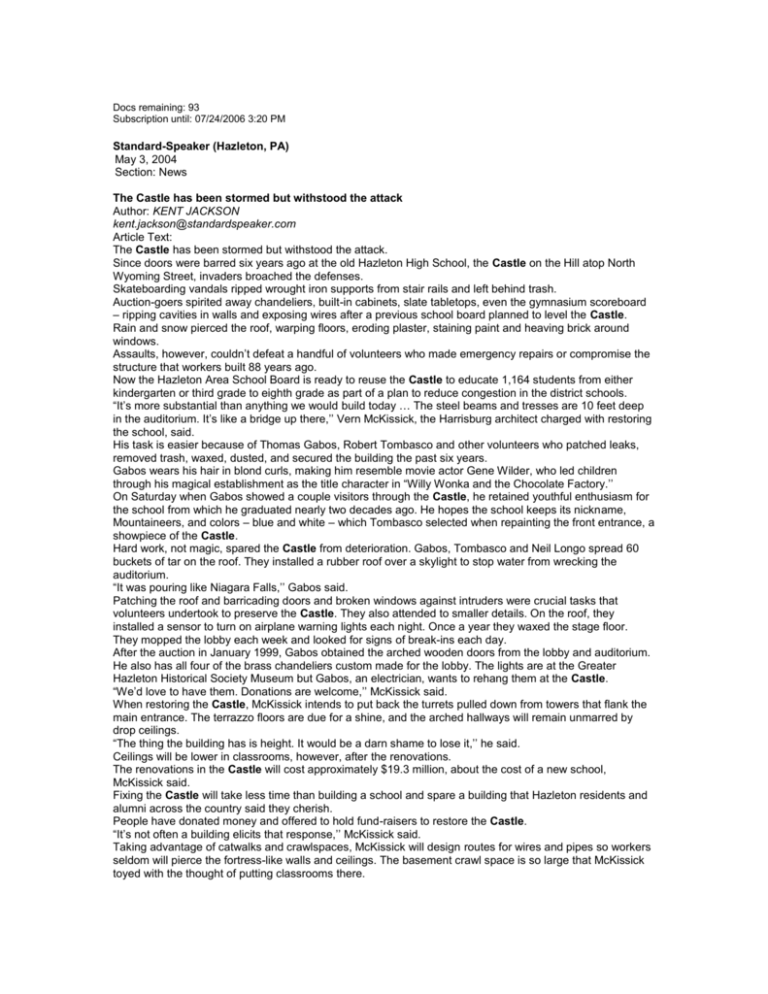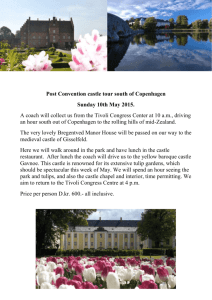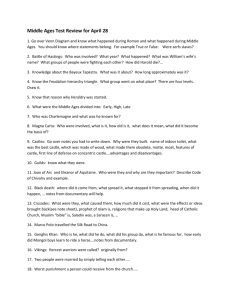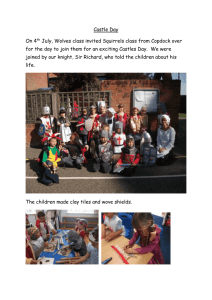
Docs remaining: 93
Subscription until: 07/24/2006 3:20 PM
Standard-Speaker (Hazleton, PA)
May 3, 2004
Section: News
The Castle has been stormed but withstood the attack
Author: KENT JACKSON
kent.jackson@standardspeaker.com
Article Text:
The Castle has been stormed but withstood the attack.
Since doors were barred six years ago at the old Hazleton High School, the Castle on the Hill atop North
Wyoming Street, invaders broached the defenses.
Skateboarding vandals ripped wrought iron supports from stair rails and left behind trash.
Auction-goers spirited away chandeliers, built-in cabinets, slate tabletops, even the gymnasium scoreboard
– ripping cavities in walls and exposing wires after a previous school board planned to level the Castle.
Rain and snow pierced the roof, warping floors, eroding plaster, staining paint and heaving brick around
windows.
Assaults, however, couldn’t defeat a handful of volunteers who made emergency repairs or compromise the
structure that workers built 88 years ago.
Now the Hazleton Area School Board is ready to reuse the Castle to educate 1,164 students from either
kindergarten or third grade to eighth grade as part of a plan to reduce congestion in the district schools.
“It’s more substantial than anything we would build today … The steel beams and tresses are 10 feet deep
in the auditorium. It’s like a bridge up there,’’ Vern McKissick, the Harrisburg architect charged with restoring
the school, said.
His task is easier because of Thomas Gabos, Robert Tombasco and other volunteers who patched leaks,
removed trash, waxed, dusted, and secured the building the past six years.
Gabos wears his hair in blond curls, making him resemble movie actor Gene Wilder, who led children
through his magical establishment as the title character in “Willy Wonka and the Chocolate Factory.’’
On Saturday when Gabos showed a couple visitors through the Castle, he retained youthful enthusiasm for
the school from which he graduated nearly two decades ago. He hopes the school keeps its nickname,
Mountaineers, and colors – blue and white – which Tombasco selected when repainting the front entrance, a
showpiece of the Castle.
Hard work, not magic, spared the Castle from deterioration. Gabos, Tombasco and Neil Longo spread 60
buckets of tar on the roof. They installed a rubber roof over a skylight to stop water from wrecking the
auditorium.
“It was pouring like Niagara Falls,’’ Gabos said.
Patching the roof and barricading doors and broken windows against intruders were crucial tasks that
volunteers undertook to preserve the Castle. They also attended to smaller details. On the roof, they
installed a sensor to turn on airplane warning lights each night. Once a year they waxed the stage floor.
They mopped the lobby each week and looked for signs of break-ins each day.
After the auction in January 1999, Gabos obtained the arched wooden doors from the lobby and auditorium.
He also has all four of the brass chandeliers custom made for the lobby. The lights are at the Greater
Hazleton Historical Society Museum but Gabos, an electrician, wants to rehang them at the Castle.
“We’d love to have them. Donations are welcome,’’ McKissick said.
When restoring the Castle, McKissick intends to put back the turrets pulled down from towers that flank the
main entrance. The terrazzo floors are due for a shine, and the arched hallways will remain unmarred by
drop ceilings.
“The thing the building has is height. It would be a darn shame to lose it,’’ he said.
Ceilings will be lower in classrooms, however, after the renovations.
The renovations in the Castle will cost approximately $19.3 million, about the cost of a new school,
McKissick said.
Fixing the Castle will take less time than building a school and spare a building that Hazleton residents and
alumni across the country said they cherish.
People have donated money and offered to hold fund-raisers to restore the Castle.
“It’s not often a building elicits that response,’’ McKissick said.
Taking advantage of catwalks and crawlspaces, McKissick will design routes for wires and pipes so workers
seldom will pierce the fortress-like walls and ceilings. The basement crawl space is so large that McKissick
toyed with the thought of putting classrooms there.
“It’s not a crawl space. It’s a walking space,’’ he said.
Two rooms that suffered the worst water damage on the east end of the Castle – along Garibaldi Court
facing the Third Base Luncheonette – will be razed. In their place, McKissick will build a two-story addition
that will make the school look like an “H,’’ a shape shown on original blueprints but never finished.
The addition will provide 18,000 square feet to hold a kitchen and mechanical structures on the first floor and
science laboratories and restrooms on the second floor.
McKissick is thinking of making the library into an art room.
“The skylight – we’ll reopen that to let in nice light for art,’’ he said of the leaded glass structure, now missing
two diamond-shaped panes, in the ceiling of the room.
McKissick set aside other space for a new library, computer and technology labs and music instruction.
Some brick will be replaced or repointed, especially around windows. Above the windowsills, water seeped
in, rusting and expanding steel inserts that pushed and cracked brick.
Water no longer fills the swimming pool, although tiles still line walls and the floor angles down into the deep
end.
Rather than practice can-openers off the decks, students in two years or so will be more likely to open cans
of fruit in the pool, which McKissick plans to fashion into a cafeteria.
The pool lacks windows, but McKissick will add them to bring light to mealtime.
A one-story addition that housed shop classes on the north side of the building along 11th Street will be
razed to admit light to the cafeteria and to create parking spaces.
The Castle also has a dungeon, a nickname given to a brick addition on the west side facing Manhattan
Court.
Despite the nickname, the classrooms there aren’t gloomy; they are among the largest in the building.
McKissick thinks they are suited for the youngest grades.
Other classrooms are too small for current standards. McKissick will enlarge them by demolishing walls to
merge three classrooms into two that still correspond with the windows.
Now that Gabos sees how McKissick plans to retrofit the school, he wonders why earlier school boards
wanted to abandon it.
Rather than lose the Castle, Gabos and others formed a committee that sought to reincarnate the school as
a community center, perhaps with a planetarium.
Tombasco, developer Michael Greco Jr., Jean Gormley of the historical society, Michael Marsicano, a
former Hazleton mayor, and school Director Dr. Robert Childs helped that effort.
Perhaps no one fought harder to save the Castle than Gilbert Degenhart, a former school director, whom
the current directors recently commended when announcing their new plans for the school.
“You wonder after seven years, why did it take so long to finalize this?’’ Degenhart said last week.
Degenhart’s memories of the school date to 1945 when he and his immigrant parents moved to Hazleton
from Sheppton, where the high school was smaller.
One Sunday, he took his father, Karl, and mother, Frances, for a walk from their home downtown to see his
new school.
When the school came into view, Karl Degenhart stopped.
“He was a miner. I thought he was having shortness of breath,’’ his son recalled. “He said to my mom in
German ‘Look at the Castle on the hill. We are back to Germany.’”
Copyright 2004, 2005 Standard-Speaker, All Rights Reserved.
Record Number: 10DE97CE3990E6FF
Record 322 of 671
Estimated printed pages: 4








